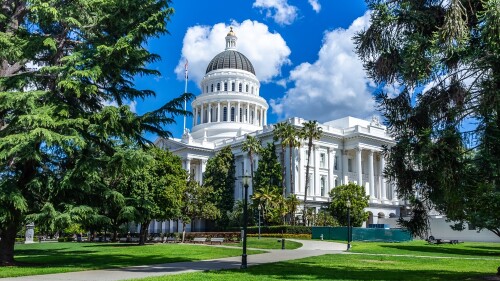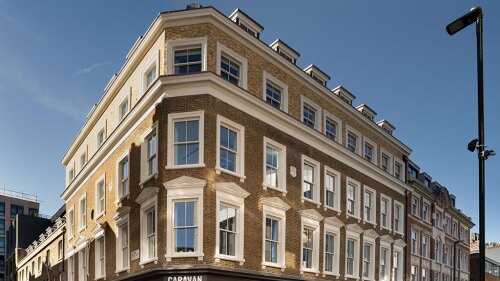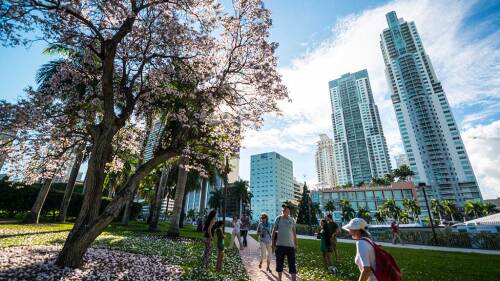Markets
Urban Land Magazine covers all of the major commercial real estate markets and property types. Some of the largest include Dallas-Fort Worth, Los Angeles, San Francisco, Chicago, and New York City. ULI also hosts two meetings per year for its membership in many of these cities, with upcoming meetings in Nashville and Miami in 2026.
Chicago
Despite improving return-to-office numbers, the office sector still battles numerous challenges that are resulting in higher loan defaults. According to MSCI Real Assets, office leads the charge on rising distress levels, which have not been seen in more than a decade. Office accounts for nearly half of outstanding distress: $51.6 billion in outstanding distress at the end of fourth quarter 2024, and another $74.7 billion in office properties identified as at risk for “potential” distress.
Four experts discuss how to rebuild urban cores by bringing the public and private sectors together to create thriving downtowns that entice remote workers to return to the office and broaden the mix of uses.
Consumers have kept a steady foot on the gas this year. A record-high 197 million consumers shopped in stores or online over the Thanksgiving holiday weekend, according to the National Retail Federation (NRF). The NRF forecasts that holiday sales will grow between 2.5 percent and 3.5 percent, with total retail spending in the United States falling between $979.5 billion and $989 billion during November and December. That forecast also is consistent with NRF’s annual U.S. sales growth—between 2.5 percent and 3.5 percent—for 2024.
Dallas
In 2025, the country’s industrial market is experiencing a rebalancing in the wake of surging demand and record new supply that marked the early pandemic years. New opportunities in fast-growing markets are emerging, and demand drivers are shifting. New space demand will grow the most, especially for small-bay industrial assets, according to a Q3 2025 report from the business advisory and accounting firm Plante Moran.
Around the turn of the 21st century, downtown Kansas City, Missouri, faced challenges familiar to many American cities: abandoned buildings and surface parking lots filled 10 core blocks despite multiple redevelopment attempts dating to the 1960s. The downtown residential population was sparse, and some 60,000 downtown office workers made haste for the suburbs at 5 o’clock each weekday.
Drawing on insights from more than 1,700 leading real estate investors, developers, lenders and advisors across the U.S. and Canada, the report identifies key opportunities, risks and market shifts that will shape the industry in the coming year.
Los Angeles
The opportunity to plan and design more than 50 acres of inner-city urban development in any city is significant, but in Pasadena, California, it is a possible inflection point in the city’s history, an opportunity to redress past mistakes, and to set the stage for future generations to benefit from perceptive and forward-thinking planning.
“It really is about addressing community through the equity and justice lens, and the inclusion lens, to positively impact communities that have been historically disinvested in and undervalued,” said Gabrielle Bullock, principal and chief diversity officer at Perkins&Will L.A. Studio. She made the remarks at the ULI Spring Meeting in Denver during the panel, “Transformative Urban Corridors: Equitable Revitalization of Communities in Three Cities.”
In a landmark moment for California housing policy, Governor Gavin Newsom signed two transformative bills into law in June 2025—AB 130 and SB 131. They fundamentally reshape how the California Environmental Quality Act (CEQA) applies to infill housing. Enacted as part of the state’s broader budget package, these reforms remove major procedural barriers for urban multifamily projects and signal a new direction in the state’s effort to address housing affordability through increased supply.
New York City
District Galleria, the name of a redevelopment plan in White Plains, New York—the county seat of Westchester—will demolish a four-and-a-half-decade-old enclosed mall and transform it into a community-oriented, mixed-use residential and retail space. The development team behind the multi-billion-dollar project is Pacific Retail Capital Partners (PRCP), which formed a joint venture with mall owner Aareal Bank, local developer Louis Cappelli of the Cappelli Organization, and New York’s SL Green Realty in 2022.
The ongoing challenges in decarbonizing skyscrapers, warehouses, apartments, and myriad other types of buildings were a key topic during ULI’s 3rd Real Estate Developer & Utility Convening on September 22—part of Climate Week NYC, the largest climate conference outside of the United Nations’ COP.
Climate Week NYC, run by the nonprofit Climate Group and held in parallel with the United Nations General Assembly, makes its annual return this September 21–28 with hundreds of in-person, hybrid, and virtual events. This jam-packed week brings together a powerful cross-section of climate leaders, including inspiring activists; visionary artists; and industry leaders in real estate, business, finance, and government.
San Francisco
ULI’s Homeless to Housed (H2H) initiative, launched after publication of the report Homeless to Housed: The ULI Perspective in 2022, highlights the numerous real estate-driven solutions that have been undertaken in recent years to tackle the problems of affordable housing and homelessness in cities across the country.
Molly Maybrun, chief development officer of local developer Fifth Space, and Wallace Whittier, senior real estate officer for University of California, San Francisco, spoke at the 2025 ULI Fall Meeting about their collaboration to build a new proton therapy cancer center at Fifth Space’s Dogpatch Power Station, a multiphase master-planned mixed-use development on the waterfront at the southern edge of San Francisco’s Mission Bay.
“The primary advantage every modular project has, if you do it right, is time savings,” said Mark Donahue—principal, design, for Lowney Architecture—during the “Offsite Evolved: How Today’s Prefab, Modular, and 3D-Printing Solutions Deliver Proven Speed, Savings, and Scale” panel at the ULI Fall Meeting in San Francisco. “You can, on a, say, 24-month construction project, save six to eight weeks.”
Toronto
Across North America, cities are confronting a housing crisis that demands urgent, innovative responses. In Toronto, the launch of the Rapid Housing Initiative (RHI) in April 2020 marked a pivotal moment—an accelerated effort at the height of the pandemic to deliver safe, stable housing. Since then, unprecedented investments have been made in communities across Ontario to address housing insecurity, reshaping the province’s residential landscape.
Canada’s real estate market is in the midst of a pivotal shift as the Bank of Canada (BoC) rolls back what has been “higher for longer” interest rates. Yet despite welcome relief on financing costs, real estate leaders are still moving somewhat cautiously amid uncertainty and fluid market dynamics.
Obsolete buildings will constitute up to 50 percent of all new housing in cities
London
Ten built environment projects from eight countries across the EMEA region have been announced as the finalists in the sixth annual ULI Europe Awards for Excellence, which recognize exemplary projects and programs in the private, public, and non-profit sectors. This year’s finalists comprise cutting edge refurbishment, restoration and new build projects, and include residential, healthcare, mixed use, education, community, laboratory, and office projects from Italy, Germany, the UK, Belgium, Sweden, Denmark, France, and Spain.
Following a masterplan adopted by British Land, the AustralianSuper pension fund, and the Southwark Council, developers are now seven years into a 15-year project to transform a 53-acre (21.44 hectares) parcel of industrial land and a former quay into a community that will include as many as 3,000 new homes, office, retail, leisure, and entertainment space.
In the heart of London’s Covent Garden neighborhood, a complex of five Victorian-era structures—previously home to a seed merchant company, a brass and iron foundry, and a Nonconformist chapel, among other uses—have been restored and adapted into a single, cohesive office building with ground-floor retail and dining space. The three-year restoration preserved the property’s industrial heritage, yet it provides enough flexibility to meet the needs of today’s workforce.
Paris
With society and the real estate industry significantly behind on achieving the targets set in the Paris Agreement, and worsening affordability in Europe’s housing, ULI Europe’s C Change for Housing program has launched a landmark interactive systems map and companion report to help the real estate industry identify, co-create, and scale the solutions needed to decarbonize existing and future affordable housing.
Although ready to commence a new real estate cycle, real estate leaders globally are braced for another challenging year of uncertainty, with lingering inflation, largely driven by factors including geopolitical instability, and persistently higher interest rates in some regions, potentially delaying a hoped-for recovery in capital markets and occupancy metrics. This is according to the Emerging Trends in Real Estate® Global Outlook 2025 from PwC and ULI, which provides an important gauge of global sentiment for investment and development prospects, amalgamating and updating three regional reports which canvassed thousands of real estate leaders across Europe, the United States and Asia Pacific.
The outlook for the European real estate market is cautiously optimistic despite growing geopolitical uncertainty and concerns about economic growth, with London, Madrid, and Paris emerging as the standout performers, according to a new report by PwC and the Institute.
Hong Kong
At the 2025 ULI Asia Pacific Summit—May 26–29, in Hong Kong—a panel of Asian economic and geopolitical experts addressed one of today’s most immediate global concerns: the implications of U.S.–China economic decoupling and the broader geopolitical shifts reshaping global trade and investment.
Fourteen developments from across Asia have been named winners of the 2025 ULI Asia Pacific Awards for Excellence, one of the real estate industry’s most prestigious honors. Announced at the 2025 ULI Asia Pacific Summit held in May in Hong Kong, this year’s award winners include projects in Australia, Bangladesh, China, India, Japan, the Philippines, and Singapore.
The creation of public space from unused, underused, or unequally shared linear spaces in urban areas has been happening for a long time. Major reference points in the architectural and planning worlds are Boston’s Emerald Necklace, designed by Frederick Law Olmsted (1878–1896); Freeway Park in Seattle (1972-1976); the Baltimore Inner Harbor (1963–1983); the Promenade Plantée in Paris (1987-1994); and the High Line in New York (2005–2019).
Singapore
The 2026 Emerging Trends in Real Estate® Asia Pacific report, published jointly by ULI and PwC found a mood of cautious optimism among real estate professionals; however, respondents described considerable disparities in markets and sectors across the region. Tokyo was ranked as the top city for investment in the Emerging Trends survey, top of the table for the third consecutive year, followed by Singapore, Sydney, Osaka, and Seoul.
A seminar organized by the ULI Singapore NEXT Committee presented attendees with the little-known concept of real estate “tokenization,” or fractional investing/trading, as a potential bridge between private investors and direct ownership. Although not new, tokenization in real estate is a niche market, particularly in Asia Pacific, with Singapore hosting a small number of the specialized digital platforms.
Once the site of an abandoned quarry, Singapore’s Rifle Range Nature Park now serves as a buffer zone protecting one of the island nation’s last primary rainforests, Bukit Timah Nature Reserve, from encroaching development and human activity. Located to the reserve’s south, Rifle Range is Singapore’s first net-positive energy nature park, harvesting more energy than its annual operational requirements.





























